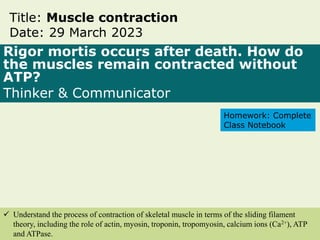
Muscle contraction.pptx
- 1. Rigor mortis occurs after death. How do the muscles remain contracted without ATP? Thinker & Communicator Title: Muscle contraction Date: 29 March 2023 Understand the process of contraction of skeletal muscle in terms of the sliding filament theory, including the role of actin, myosin, troponin, tropomyosin, calcium ions (Ca2+), ATP and ATPase. Homework: Complete Class Notebook
- 2. First things first…! What types of muscle do you know? Skeletal (conscious contraction) Smooth (unconscious contraction) Cardiac (unconscious contraction)
- 3. How is a rope like a muscle fibre?
- 5. The structure of striated skeletal muscle. Each muscle is called a fibre. Each fibre made up of a bundle of myofibrils. Each myofibril is made of myofilaments - actin and myosin. The myofilaments are arranged so that each myosin is surrounded by 6 actins
- 6. A bit of added strength! The muscle cells are fused together (fibres) and share nuclei and cytoplasm called sarcoplasm.
- 7. Sarcomere
- 8. Microscopic structure The lighter bands are called I bands (isotropic). They are lighter because the actin and myosin filaments are not overlapping The darker bands are called A bands (anisotropic). They are darker because the actin and myosin filaments are overlapping Task: Add labels to your sarcomere and draw a diagram to represent the actin and myosin filaments H Zone Note: STRIATED MUSCLE. : muscle tissue that is marked by transverse dark and light bands
- 9. Let’s take a simpler look! Thin! Thick!
- 10. The structure of actin It consists of 2 threads wrapped around each other. At each twist there is a binding site for myosin. In a relaxed state, a molecule called tropomyosin covers these sites.
- 11. The structure of myosin The filament consists of many myosin molecules. Each molecule has a tail and a double globular head. The head attaches to the myosin binding sites on the actin where the actin and myosin filaments overlap. These attachments are called cross-bridges. The heads contain ATPase enzyme which releases energy from ATP to power muscle contraction.
- 12. Muscle contraction Contraction occurs when an impulses from a motor neurone reaches the synapse at the junction with the muscle.
- 13. Sliding filament Hypothesis. Acetylcholine, a neurotransmitter substance, is released into the synapse, diffuses across and attaches to specific receptors on the sarcolemma (the outer membrane of the muscle fibre). The muscle sarcolemma is depolarised. Depolarisation spreads along the fibre. This causes calcium to be released from the sarcoplasmic reticulum into the sarcoplasm. Calcium displaces tropomyosin, thus uncovering the myosin binding sites on the actin filaments. ATP attached to the myosin heads cause them to flex and attach to the actin in the overlapping areas. ATP is hydrolysed to ADP + P. The energy released causes the heads to alter their angle to their tails. This pulls the actin filament past the myosin filament. The cross-bridges detach and reattach, this time further along the actin filament. https://www.youtube.com/watch?v=aUc3h6LvdJ 4
- 16. Rigor mortis occurs after death. How do the muscles remain contracted without ATP? Understand the process of contraction of skeletal muscle in terms of the sliding filament theory, including the role of actin, myosin, troponin, tropomyosin, calcium ions (Ca2+), ATP and ATPase. ATP is only required to relax and “reset” the muscle, not to contract. No ATP means muscle remains contracted